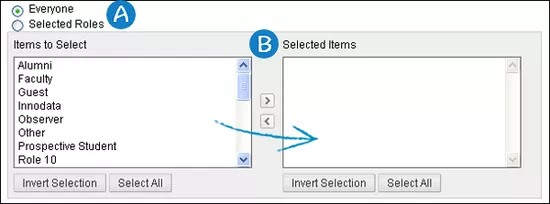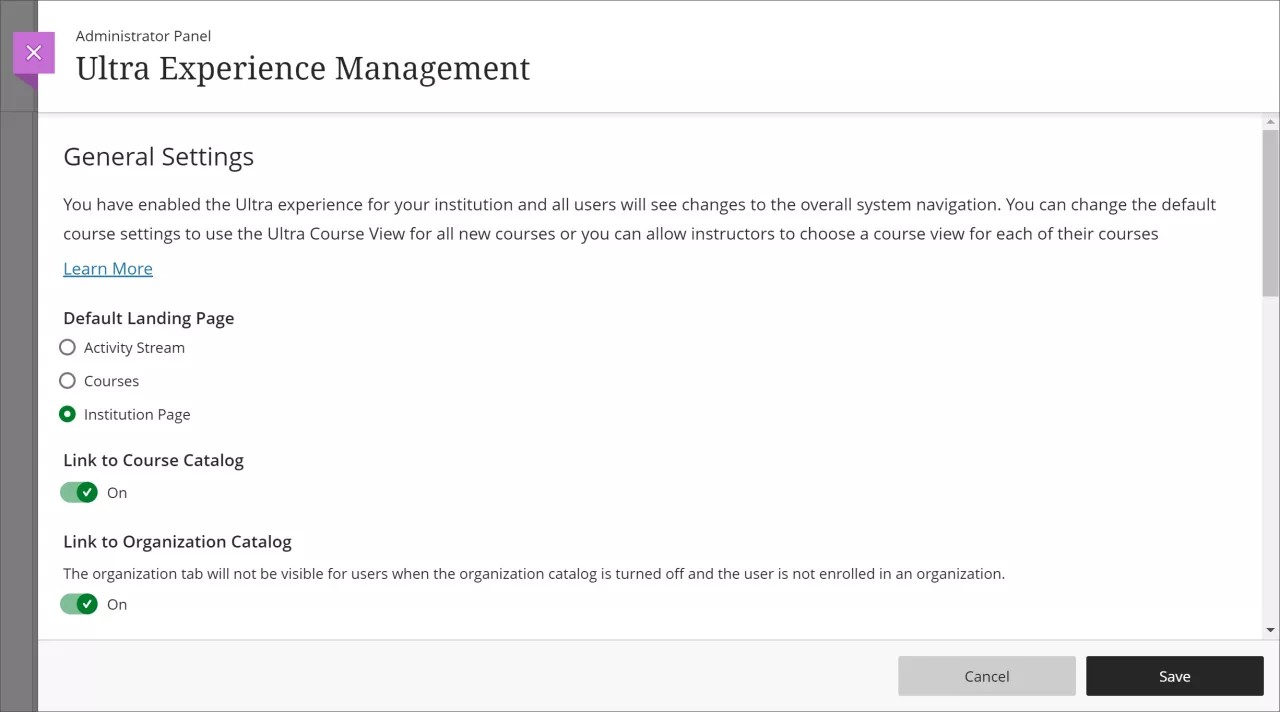You can use the course catalog to let users browse the available or upcoming courses at your institution. In Original Course View, you can also grant guests access to the course catalog to help inform prospective students.
The course catalog groups courses into categories. When a course is assigned to a category, it appears automatically in the course catalog. Courses that are set to Unavailable don't appear in the course catalog.
You can use categories and subcategories to create a catalog hierarchy that matches the departmental structure of your institution.
For example, the History category might have numerous subcategories, including Ancient History and World History. The World History category might contain African History, American History, Asian History, and European History. The American History category might contain North America and South America categories.
Example:
History
>World History
>>American History
>>>North America
>>>South America
You can have multiple categories with the same name. However, the category ID must be unique. For example, every top-level category can have a subcategory with a category name of Advanced Courses and a category ID of adv_01, adv_02, adv_03 and so on.
View subcategories
- On the Administrator Panel in the Courses section, select Course Catalog.
- Select the name of the parent category. The next level of the hierarchy appears.
- Continue to select category names to drill down through the levels.
- To return to a higher category, select its name in the hierarchy path. For example, if the hierarchy path displays Top Level > Language Arts > Comparative Literature > Myths and Legends, select Language Arts to return to the second level.
- To return to the top level, select the Top Level link in the hierarchy path.
Create or edit a category
- On the Administrator Panel in the Courses section, select Course Catalog.
- Select Create Category. This table describes the available fields. [r] indicates a required field.
Category Available Fields Field Description Create/Edit Category Category Display Name[r] Provide a name for the category. The category name doesn't have to be unique. For example, you can have three categories called Advanced Courses. You can change category names at any time. Category ID [r] Provide a category ID. The category ID must be unique within Blackboard Learn. For example, if you have three categories called Advanced Courses, create three different category IDs, such as adv_01, adv_02, and adv_03. Category IDs can contain numbers, letters, hyphens (-), underscores (_), and periods (.). All other characters, including spaces, are prohibited.
You can't change category IDs after they've been set.
Description Provide a detailed description of the category. Display Category on Top in Catalog View Select this check box to display the category on the first page of the course catalog. Availability Select Yes to make the category available to courses throughout Blackboard Learn. Select No to make the category unavailable. To If you selected Everyone, skip to the next step. If you selected Specific Roles, in the Items to Select list, select the roles to make this module available to. Select the right-pointing arrow to move the items into the Selected Items list. To reverse the selection in either box, select Invert Selection.
- Make this category available to all users (Everyone)or restrict access by user's institution role (Selected Roles).
- If you restrict access by role, select a role to select it. Then select the arrow to move it to the other list.
- Select Submit.
Enable or disable the course catalog link on the start page
- On the Administrator Panel in the Security section, select Gateway Options.
- In the Gateway Functionality section, select one of these options:
- Disable: Removes the link to the course catalog from the user start page.
- Enable: Includes a link to the course catalog on the user start page.
- External Catalog URL: Includes a link to an external catalog rather than the Blackboard Learn course catalog. Provide the full URL, including http://.
ULTRA: Enable the course catalog
You can enable users to open and browse the course catalog in the Ultra experience. Available courses in the Original Course View and the Ultra Course View appear in the course catalog. Users can open the courses and view contents, but they can't interact with the content. This information also pertains to organizations. If the guest option is enabled, guests can access Original courses that are set to available.
- On the Administrator Panel in the The Ultra Experience is here! section, select Configure.
- Next to Link to Course Catalog or Link to Organization Catalog, select Enabled to enable one or both course catalogs for your institution.
- Select Submit. The link to the catalog appears on the Courses page and the Organization page in the Ultra base navigation.
Guest access
If you want to allow unauthenticated users to browse the courses offered at your institution, you can allow guest access to the course catalog. Guests don't need to log in to view the catalog.
Guest access isn't supported in the Ultra Course View. Guests can see available courses in Original Course View and Ultra Course View in the Course Catalog if these courses are set to available. Guests can further access Original courses as long as they are set to available. If a course doesn't allow guest access, the guest can see the course in the list, but can't open it.
- On the Administrator Panel in the Security section, select Gateway Options.
- In the Gateway Functionality section, select Enable. This setting displays a link to the course catalog on the login page.
- In the Guest Access Defaults section, select Enable next to Allow Guest Access to Courses. If guest access is disabled, guests can browse the course catalog but can't see any content when they view a course. An Access Denied message appears.
- Select Submit to save your changes.
- Log out to confirm that the View Course Catalog link appears as expected.
ULTRA: What do students and instructors see?
Instructors and students can access the course catalog on the Courses page. In the catalog, users can browse available courses in the Original Course View and the Ultra Course View by the categories or terms you've associated. Or they can use the search functions to find courses by ID, description, instructor, name, or term. Self-enrollment is supported for authenticated users.
If you enable guest access to the course catalog, guests may only enter courses in the Original Course View that are set to available.



